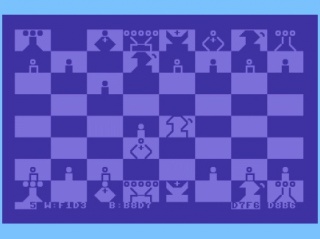PetChess
Revision as of 12:26, 30 May 2020 by GerdIsenberg (talk | contribs) (Created page with "'''Home * Engines * PetChess''' FILE:c64_petchess4000_emulator_scr2.jpg|border|right|thumb|320px|link=http://www.spacious-mind.com/html/c64_emu_-_petchess...")
PetChess, (PetChess 4000, Pet Chess 8000)
a chess program for the Commodore PET, released in 1981 by Philidor Software.
According to Mike Watters, PetChess was written by Mark Taylor [2].
A similar program was released in 1983 by Norgayer Software for the Commodore 64 and 128 under the name Microchess 3,
which associates Peter Jennings, author of the 1976 MicroChess was involved
[3]
[4].
However, it seems Microchess 3 was an alias name of PetChess, with Mark Taylor as author as well
[5].
Description
excerpt from John F. White's 1982 review [6]
There is a substantial book-opening library of 3,700 moves, although whether a computer should play the dubious von Hennig-Schara gambit is open to doubt. Moves may be taken back to the beginning and an action replay is available to repeat moves. The program uses iterative deepening for its moves and the best move yet found is constantly displayed, as is the move under consideration, and the player can halt the machine’s thinking at any time. Moves are not randomly selected – except in the opening – instead the player can select the next best move and play on from there. Draws under the 50-move rule, stalemate or three-fold repetition are also recognised.
The entire program and its style of play is reminiscent of Philidor’s Intelligent Chess, although there is a greater emphasis on pawn moves. The evaluation function is evidently very sophisticated, but it takes a long time to search at the lowest levels. It seems that subsequent levels are only sketchily evaluated, and the program rarely changes its mind about a move found at the lowest level. As a result, PetChess falls into simple traps at these levels – up to one minute, which covers half of the available levels – because of its inability to see far ahead. At higher levels, it avoids the traps, but tends to exchange everything it can. Like so many programs, it likes to exchange its bishops for knights early in the game, and it also prefers to double its pawns rather than move its queen before castling – I detect Levy’s hand. PetChess shows some evidence of strategic thinking in moving pawn majorities against minorities or in moving major pieces into attack positions against the enemy king. This, again, shows the thought that has been put into the evaluation function. The end-game play is, however, rather weak, and the king seems to be a little passive.
Publications
- John F. White (1982). Review-Chess Computers. Your Computer, March 1982
External Links
- Petchess 4000 : Philidor Software : Free Download, Borrow, and Streaming : Internet Archive
- Commodore 64 Emulator - Computer Chess Game Collection - Petchess 4000, The Spacious Mind
- Game music base - database of Games, Games music and soundtracks | Pet Chess 4000 aka Microchess 3.0
- Petchess 8000 for Commodore PET/CBM (1981) - MobyGames
References
- ↑ Commodore 64 Emulator - Computer Chess Game Collection - Petchess 4000, The Spacious Mind
- ↑ Chess Computers - The UK Story by Mike Watters
- ↑ Microchess – C64-Wiki (German)
- ↑ Commodore 64 Emulator - Computer Chess Game Collection - Microchess 3, The Spacious Mind
- ↑ Game music base - database of Games, Games music and soundtracks | Pet Chess 4000 aka Microchess 3.0
- ↑ John F. White (1982). Review-Chess Computers. Your Computer, March 1982
